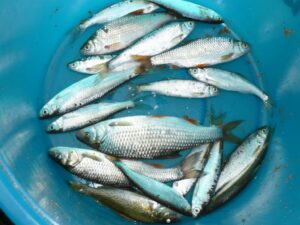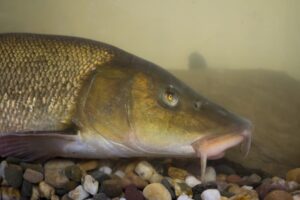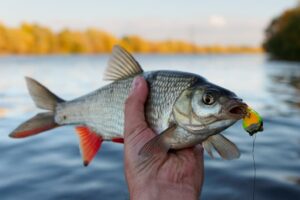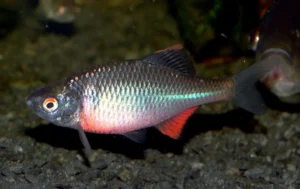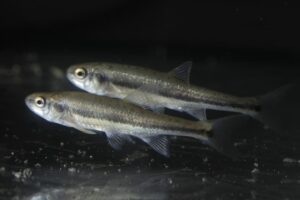Panfish : Vairone (Telestes souffia)
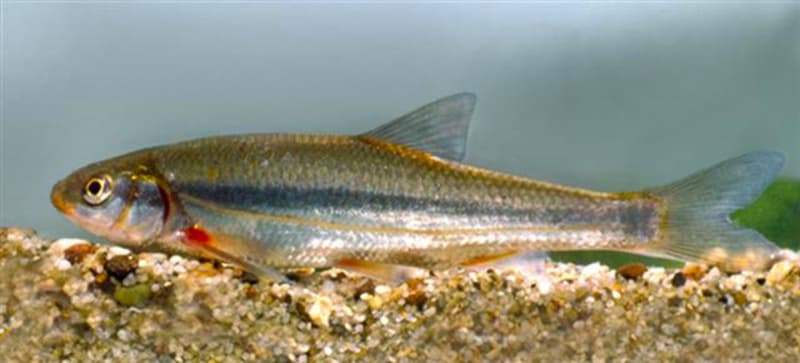
Are you an angler keen on exploring new species of panfish? The Vairone, scientifically known as Telestes souffia is a fascinating freshwater fish that calls Europe’s perialpine regions home.
This blog will guide you through everything from its characteristics and behaviour to effective fishing techniques and responsible practices for its conservation. Let’s dive into the world of this elusive aquatic creature!
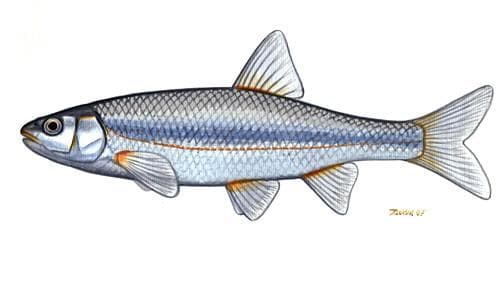
The Vairone: Telestes souffia
The Vairone, also known as Telestes souffia, is a freshwater fish found in various regions.
Description and characteristics
The Vairone is a fascinating freshwater fish with a slender silhouette that exemplifies its agile swimming abilities. Its body shape, known as fusiform, features a short conical head coupled with an oblique mouth which adds to its distinct characteristics.
This small wonder of the water world boasts cycloid scales and pharyngeal teeth, elements contributing significantly to its swift movements under water. Spanning over this unique frame are hues from nature’s palette; an enchanting dark brown with metallic blue reflections adore the dorsal side while silver gleams on flanks leading to a whitish foundation – the belly of this aquatic marvel.
Notably, hints of brownish to yellowish shades can be found in their fins emitting soft green reflections under certain lights. This captivating spectacle comes alive in male Vairones measuring around 9-12 cm and females reaching up till 15-20 cm in length each weighing approximately around 100 g when matured enough.
| Class |
| Actinopterygii |
| Order |
| Cypriniformes |
| Family |
| Cyprinidae |
| Genus |
| Telestes |
| Species |
| T. souffia |
| Binomial Name |
| Telestes souffia (Risso, 1827) |
Habitat and behavior
The Vairone, or Telestes Souffia as scientists call it, stakes its claim in fast-flowing, oxygenated waters. Brightening up clear rivers and bustling mountain torrents with their lively presence.
This panfish particularly loves a good gravel or pebble bottom – the sign of high-quality water that makes every angler excited. Don’t just look down though! They’re also known to venture into high-altitude lakes, using the shallow oxygen-rich areas as their playgrounds.
The conspicuous liveliness extends to their behaviour too; these freshwater fish never shy away from using currents for travel and food hunting adventures. If you spot a small group darting about together, chances are you’ve found your Vairones socialising for feeding and protection purposes! Their well-rounded diet relies on aquatic invertebrates like insect larvae, small crustaceans and worms – all fairly common constituents of freshwater ecosystems.
As spring rolls around between April and June bringing warmer temperatures with it, they kickstart their reproduction process to ensure the survival of this playful species.
Ecological role
The Vairone, or Telestes Souffia, plays a crucial ecological role in freshwater habitats. As an integral part of the food chain, it acts as both predator and prey within its ecosystem.
Predominantly feeding on small insects and larvae, it helps control the population of these aquatic dwellers while providing nourishment for larger species. Importantly, this panfish acts as a valuable biological indicator of water quality due to its sensitivity to pollutants and habitat changes.
Consequently, fishers and anglers can look at the health of Vairones in their local waters to gauge environmental conditions effectively. Therefore, your efforts in supporting conservation measures are pivotal in keeping our water bodies clean and preserving the balance of aquatic ecosystems.
Fishing Techniques for Vairone
To catch Vairone, try pole fishing with a float in small streams, fly fishing in fast-flowing rivers, or toc fishing in oxygenated rivers.
Pole fishing with float in small streams
Learning the skill of pole fishing with a float can bolster your chances of netting Vairone in small streams. This technique utilises a rod without a reel, and instead uses a line equipped with a float and baited hook.
Keeping stealthy is paramount as the Vairone is quite wary, so strive for discretion while casting your line into peaceful streams. Use baits that are irresistible to these panfish – worms, insect larvae or even small pieces of dough work wonders for enticing the freshwater fish.
Precision in both your throw and location choice plays an integral role in determining your success with this method.
Fly fishing in fast-flowing rivers
Fly fishing is a proven method for catching Telestes Souffia. It calls upon the use of artificial flies or insect imitations to lure these panfish into your grasp. The focus is on replicating the natural movements of the Vairone’s prey, which requires not only skill but also an understanding of their feeding habits and preferences.
This technique has been refined over generations, making it a highly effective approach in fast-flowing rivers. Still, mastering fly fishing demands patience from all anglers – it takes time to perfectly mimic the prey so as to entice this freshwater fish successfully.
Alongside its effectiveness, meticulous execution makes fly fishing a captivating process that leads you into connecting deeply with nature.
Toc fishing in oxygenated rivers
Toc fishing, a quick and effective method, works wonders in oxygenated rivers teeming with fast-moving Vairones. The trick lies in making the bait mimic food drifting along the river’s bottom, fooling these fish into biting.
Armed with a light rod, thin line and minimal weight, you keep your bait close to the river bed where vairone are most likely found. Opt for natural baits like larvae or worms as they seem more authentic to these smart predators.
Just make sure you’re highly alert because Vairones bite subtly; miss it and you’ve lost your catch! Thus toc fishing lets anglers outsmart their aquatic friends using nature’s own tricks.
Responsible Fishing Practices for Vairone Conservation
Practice responsible fishing for Vairone conservation by catch and release, respecting minimum size limits, and considering reproductive periods. Learn more about these important practices to help protect this freshwater fish species.
Catch and release
As anglers, adopting the practice of catch and release will significantly contribute to the sustainability of Vairone. This method ensures you play an active role in preserving this freshwater fish species for future generations.
The catch and release approach maintains stable populations of Vairone by ensuring that caught fish are returned alive back to their habitat. It’s not just about helping these panfish survive; it also preserves them as valuable biological indicators of water quality.
So, next time you reel in a Vairone, consider using this responsible fishing practice – your actions can make a big impact on their conservation!
Respect minimum size limits
Respecting minimum size limits is a crucial aspect of responsible fishing for Vairone. By adhering to these limits, you can help ensure the sustainability and conservation of this freshwater fish species.
The average size of male Vairone is between 9 and 12 cm, while female specimens can grow up to 15 to 20 cm in length. It’s important to remember that some Vairone individuals may exceptionally reach a length of 25 cm.
By respecting the minimum size limits set for catching Vairone, you give them an opportunity to reproduce and maintain healthy populations. This practice allows younger fish to mature, ensuring their ability to continue breeding in the future.
Consider reproductive periods
During the reproductive period of Vairone, which usually takes place between April and June, it’s important to be mindful of the impact our fishing activities can have on their population and ecosystem.
By avoiding fishing during this critical time, you are giving the Vairone a better chance to successfully reproduce and maintain healthy populations. This responsible approach helps preserve their habitat and ensures a sustainable future for these freshwater fish.
Common name for the Vairone
Most popular common names for the Vairone are Blageon (french), Forel (Dutch), Strömer (german) and Strigione (italian).
Threats to Vairone and Conservation Efforts
The Vairone, or Telestes souffia, faces several threats to its survival and conservation efforts are crucial in protecting this species.
Water pollution
Water pollution poses a significant threat to the Vairone, a freshwater fish that is important for both anglers and the ecosystem. The presence of pollutants in its habitat can have detrimental effects on the Vairone’s health and survival.
Chemicals and toxins from industrial waste, agricultural runoff, and improperly treated sewage can contaminate the water, affecting not only the Vairone but also other aquatic species.
It is crucial for fishers and anglers to be aware of this threat and take measures to prevent further water pollution in order to protect this valuable panfish species.
Habitat modification
Habitat modification poses a significant threat to the Vairone’s population decline. Human activities like dam construction and water pollution contribute to altering the Vairone’s habitat.
These freshwater fish thrive in fast-flowing and oxygenated waters, which are negatively impacted by habitat modifications. Moreover, gravel and pebble bottoms, indicators of good water quality preferred by the Vairone, can also be affected.
To preserve the Vairone’s habitat, it is crucial to prioritize conservation efforts that address these issues and ensure their ongoing protection.
Overfishing
Overfishing poses a significant threat to the Vairone population. As fishers and anglers, it’s important for us to be mindful of our impact on their numbers. When we engage in excessive fishing practices, such as taking more than our fair share or targeting vulnerable populations, we contribute to the decline of this freshwater fish.
By practicing responsible fishing techniques and respecting catch limits, we can help protect the Vairone and ensure its survival for future generations.
Conservation measures for preserving water quality indicators
Preserving water quality indicators is crucial for the long-term health of the Vairone and its ecosystem. As fishers and anglers, you can contribute to conservation efforts by following these responsible fishing practices:
- Practice catch and release: Return the Vairone back into the water after catching it. This helps maintain their population and avoids unnecessary harm.
- Respect minimum size limits: Only keep Vairone fish that meet the minimum size requirements set by local regulations. This ensures that younger and smaller individuals have a chance to reproduce and sustain the population.
- Consider reproductive periods: Avoid fishing during specific times of the year when Vairone are spawning or reproducing. By giving them space during this critical phase, you help support successful breeding and growth.
- Limit bait usage: When fishing for Vairone, try to use artificial lures or flies rather than live bait. This reduces the risk of introducing invasive species or diseases that could harm both the Vairone and other native fish species.
- Participate in local conservation initiatives: Get involved with local organizations or initiatives focused on preserving water quality and protecting aquatic ecosystems. These collaborations can make a significant difference in safeguarding vital habitats for the Vairone.
Conclusion
Discover the beauty and importance of the Vairone, a unique panfish species found in Europe’s perialpine regions. By understanding its characteristics, habitat, and ecological role, you can enhance your fishing techniques for this remarkable fish.
Remember to practice responsible fishing and support conservation efforts to ensure the survival of the Vairone for generations to come. Get ready to embark on an exciting angling adventure with this freshwater gem!

